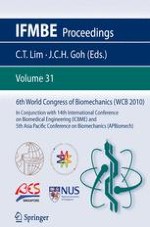2010 | OriginalPaper | Chapter
Statistical Study of Mechanics of Human Forced Expiratory Wheezes
Authors : V. I. Korenbaum, M. A. Safronova, I. A. Pochekutova, A. I. Dyachenko
Published in: 6th World Congress of Biomechanics (WCB 2010). August 1-6, 2010 Singapore
Publisher: Springer Berlin Heidelberg
Activate our intelligent search to find suitable subject content or patents.
Select sections of text to find matching patents with Artificial Intelligence. powered by
Select sections of text to find additional relevant content using AI-assisted search. powered by
The forced expiratory wheezes (FEWs) origin remains not clear even in healthy. The hypothesizes are known on FEW’s formation by means of dynamic flatter (Gavriely et al., 1987), and vortex shedding on bronchial tree bifurcations (Hardin, Patterson, 1979). The aim is statistical simulation of vortex shedding in healthy volunteers. Statistical study was carried out in 2 samples of healthy volunteers. The first of them consisted of 54 young males, performed forced exhalation (FE) with room air. Tracheal forced expiratory noises were recorded on the larynx area. The second sample included 25 subjects, performed FE with room air (a), helium-oxygen (h) and krypton-oxygen (k) mixtures. FE noises were recorded on trachea and symmetrical basal areas of right and left lungs. In the first it was found that the most powerful medium frequency FEWs (400-600 Hz) were produced in bifurcations of trachea and principal bronchi according to Hardin-Patterson’s prediction, meanwhile they must be produced in bifurcations of more deep levels of bronchial tree in accordance with Strouhal’s prediction. In the second sample the expert evaluated percentage of spectral similarity (CSC) of FEW’s recorded on the left and right areas of lungs. The analysis was based on evident hypothesis that CSC should be near 100% if FEWs were produced in bifurcation of trachea or closer to mouth. When FEWs were produced in bifurcation of more deep levels of bronchial tree, CSC value should be decreased. Averaged CSC indexes for medium frequency FEWs were: (a) 84%, (h) 90%, (k) 70%. CSC indexes obtained for (a) and (k) show spectral similarity which is quite far from 100%. It makes possible to suppose substantial impact in FEW’s production not only of bifurcation of trachea but bifurcations of principal bronchi or even more deep airways. This picture is in better concordance with extrapolated Hardin-Patterson’s prediction than with Strouhal’s one. The impact of bifurcations of airways lying deeper than trachea is sufficiently decreased in (h). It may be explained by smaller density of (h), which makes possible more substantial compression of airways.
